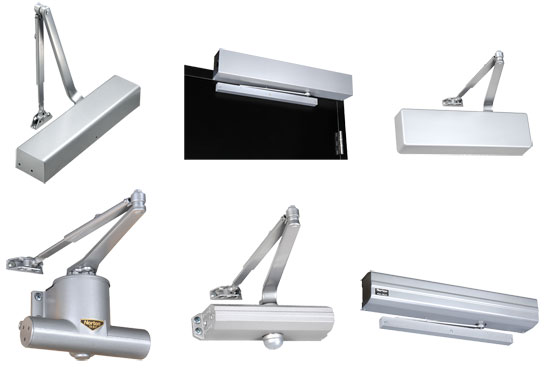Aesthetically Designed Architectural Door Openings
• Privacy function (spring latch): This set is locked by a push button from the interior side of the door and can be unlocked from the exterior side by an emergency release key.
• Privacy function (mortise bolt or mortise lock): Generally used where higher control is needed, privacy sets are available with mortise bolt or mortise lock mechanisms. They are characterized with operable handles that are locked by a turn piece from the interior side and may be unlocked by an emergency release key from the exterior.
- Emergency release refers to the capability of a lock to be unlocked from the exterior side in case of an urgent situation and is a common feature of most interior privacy lock sets.
- Exit devices are typically push bar style mechanisms that allow unencumbered egress from a space, typically used in higher occupancy areas such as public assembly areas.
Once the control function is decided upon, the lock trim materials can be selected. Lock trim refers specifically to the visible portions of the lock set that is usually attached to the surface of the door and can vary interchangeably with other parts of the lockset, including:
- Escutcheon – the back plate that attaches to the door.
- Swing Cover—the flap that covers the cylinder or the emergency release access.
- Thumb Piece—the part that retracts the latch bolt on a thumb latch entry lock set.
- Turn Piece—operates the dead bolt or mortise bolt on the interior side of a locking set.
- Handle—the part of the hardware set that is pulled or rotated to open/close the door. Juhani Pallasmaa, Honorary FAIA, Professor of Architecture, is quoted as saying “The door handle is the handshake of the building.” Since the handle is the part that we place our hands on, it is not surprising that there are many options, particularly for lever style mechanisms. Handle options include grips, levers, knobs, or ring pulls.
All of the hardware, particularly the exposed hardware, can be specified in a variety of metal colors and finishes. As such, they can blend with the overall design scheme of the space where they are located and contribute visually to the aesthetic experience.
 |
Door closers come in many shapes and sizes to accommodate the particular design needs of a door opening. It is important to coordinate their location on the door for best aesthetic results or use concealed closers to avoid visual conflicts. Photos courtesy of ASSA ABLOY |
Controlling Devices—Creating Closure
Doors that open also need to close and in many cases automatic closure is required by code since door closers maintain the integrity of fire doors along exit routes in buildings used by the general public. Similarly, to secure the function of any security door, it's critical that an automatic closing device such as a door closer is in place. The self-closing function offered by door closers also provides an important level of security for external doors, preventing them from slamming, staying open unintentionally or blowing open in the wind.
In response to these door control needs, the typical decision is to add a door closer that is mounted to both the door and the frame or some other fixed point. There are several typical choices:
- Surface closers: These are the most commonly used type of closer but aesthetically they can be a weak choice due to the exposed closure arm and rather functional look of many of them. There a variety of door closer types available ranging from surface mounted door closers, concealed door closers, door stays, floor closers, screen door closers to electromechanical door operators and closers for a variety of special needs. Some of the surface mounted types include Regular Arm (RA), Parallel Arm (PA), Top Jamb (TJ) or Slide Track operation.
- Concealed in head closers: This type is a designer's dream since all of the hardware is concealed in the door frame or head, not exposed on the outside of the door. Obviously this requires some coordination to be sure that the frame and door head can accommodate the door closing unit. It should also be pointed out that these do not function efficiently because there is little room in the body for optimal springs and hydraulics. They also require more adjustment and are not recommended for entrances or stair towers.
- Concealed floor closers: Similar to concealed head closers, door closers that are concealed in the floor are also out of sight and avoid any aesthetic interference with the look of the total door opening. Unlike concealed head closers, however, concealed floor closers are the most efficient way to hang and close a door. The closer carries the weight of the door on the floor and is completely out of sight. Obviously, coordination with the floor construction is needed to allow for the proper operation.









